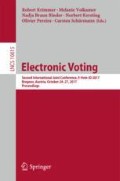Abstract
Recently, Muş, Kiraz, Cenk and Sertkaya proposed an improvement over the present Estonian Internet voting vote verification scheme [6]. This paper points to the weaknesses and questionable design choices of the new scheme. We show that the scheme does not fix the vote privacy issue it claims to. It also introduces a way for a malicious voting application to manipulate the vote without being detected by the verification mechanism, hence breaking the cast-as-intended property. As a solution, we propose modifying the protocol of Muş et al. slightly and argue for improvement of the security guarantees. However, there is inherent drop in usability in the protocol as proposed by Muş et al., and this issue will also remain in our improved protocol.
Access this chapter
Tax calculation will be finalised at checkout
Purchases are for personal use only
Notes
- 1.
Of course we assume here that the voter’s computer is honest in the sense that it does not send the QR code anywhere else. But if it would be willing to do so in order to break the voter’s privacy, it could already send away the vote itself.
- 2.
“Valimised” means “Elections” in Estonian.
References
Heiberg, S., Laud, P., Willemson, J.: The application of I-voting for estonian parliamentary elections of 2011. In: Kiayias, A., Lipmaa, H. (eds.) Vote-ID 2011. LNCS, vol. 7187, pp. 208–223. Springer, Heidelberg (2012). doi:10.1007/978-3-642-32747-6_13
Heiberg, S., Martens, T., Vinkel, P., Willemson, J.: Improving the verifiability of the Estonian internet voting scheme. In: Krimmer, R., Volkamer, M., Barrat, J., Benaloh, J., Goodman, N., Ryan, P.Y.A., Teague, V. (eds.) E-Vote-ID 2016. LNCS, vol. 10141, pp. 92–107. Springer, Cham (2017). doi:10.1007/978-3-319-52240-1_6
Heiberg, S., Parsovs, A., Willemson, J.: Log analysis of Estonian internet voting 2013–2014. In: Haenni, R., Koenig, R.E., Wikström, D. (eds.) VOTELID 2015. LNCS, vol. 9269, pp. 19–34. Springer, Cham (2015). doi:10.1007/978-3-319-22270-7_2
Heiberg, S., Parsovs, A., Willemson, J.: Log analysis of estonian internet voting 2013–2015. Cryptology ePrint Archive, Report 2015/1211 (2015). http://eprint.iacr.org/2015/1211
Heiberg, S., Willemson, J.: Verifiable internet voting in Estonia. In: 2014 6th International Conference on Electronic Voting: Verifying the Vote (EVOTE), pp. 1–8. IEEE (2014)
Muş, K., Kiraz, M.S., Cenk, M., Sertkaya, I.: Estonian voting verification mechanism revisited. Cryptology ePrint Archive, Report 2016/1125 (2016). http://eprint.iacr.org/2016/1125
Vinkel, P., Krimmer, R.: The how and why to internet voting an attempt to explain E-Stonia. In: Krimmer, R., Volkamer, M., Barrat, J., Benaloh, J., Goodman, N., Ryan, P.Y.A., Teague, V. (eds.) E-Vote-ID 2016. LNCS, vol. 10141, pp. 178–191. Springer, Cham (2017). doi:10.1007/978-3-319-52240-1_11
Wagenaar, W.A.: Generation of random sequences by human subjects: a critical survey of literature. Psychol. Bullet. 77(1), 65 (1972)
Acknowledgements
The research leading to these results has received funding from the European Regional Development Fund through Estonian Centre of Excellence in ICT Research (EXCITE) and the Estonian Research Council under Institutional Research Grant IUT27-1. The authors are also grateful to Arnis Paršovs for pointing out a flaw in an earlier version of the improved protocol.
Author information
Authors and Affiliations
Corresponding author
Editor information
Editors and Affiliations
Rights and permissions
Copyright information
© 2017 Springer International Publishing AG
About this paper
Cite this paper
Kubjas, I., Pikma, T., Willemson, J. (2017). Estonian Voting Verification Mechanism Revisited Again. In: Krimmer, R., Volkamer, M., Braun Binder, N., Kersting, N., Pereira, O., Schürmann, C. (eds) Electronic Voting. E-Vote-ID 2017. Lecture Notes in Computer Science(), vol 10615. Springer, Cham. https://doi.org/10.1007/978-3-319-68687-5_19
Download citation
DOI: https://doi.org/10.1007/978-3-319-68687-5_19
Published:
Publisher Name: Springer, Cham
Print ISBN: 978-3-319-68686-8
Online ISBN: 978-3-319-68687-5
eBook Packages: Computer ScienceComputer Science (R0)

